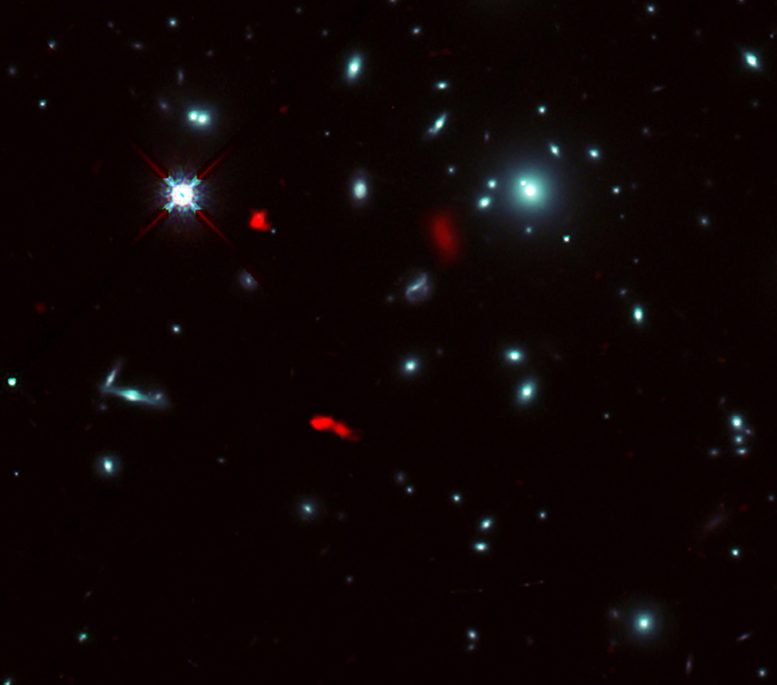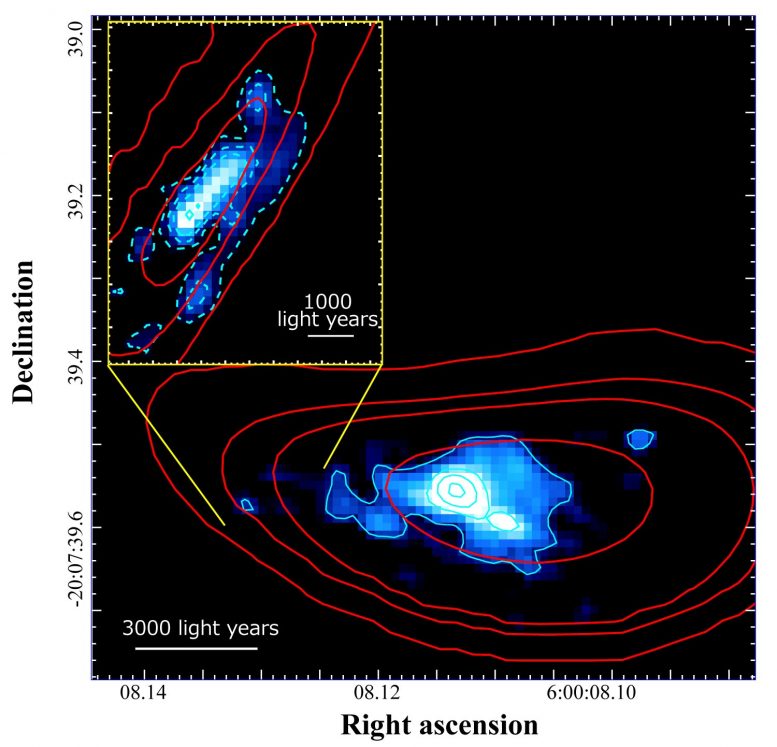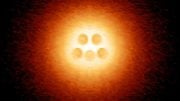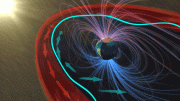
Image of the galaxy cluster RXCJ0600-2007 taken by the NASA/ESA Hubble Space Telescope, combined with gravitational lensing images of the distant galaxy RXCJ0600-z6, 12.4 billion light-years away, observed by ALMA (shown in red). Due to the gravitational lensing effect by the galaxy cluster, the image of RXCJ0600-z6 was intensified and magnified, and appeared to be divided into three or more parts. Credit: ALMA (ESO/NAOJ/NRAO), Fujimoto et al., NASA/ESA Hubble Space Telescope
Using the Atacama Large Millimeter/submillimeter Array (ALMA), astronomers found a rotating baby galaxy 1/100th the size of the Milky Way at a time when the Universe was only seven percent of its present age. Thanks to assistance by the gravitational lens effect, the team was able to explore for the first time the nature of small and dark “normal galaxies” in the early Universe, representative of the main population of the first galaxies, which greatly advances our understanding of the initial phase of galaxy evolution.
“Many of the galaxies that existed in the early Universe were so small that their brightness is well below the limit of the current largest telescopes on Earth and in Space, making it difficult to study their properties and internal structure,” says Nicolas Laporte, a Kavli Senior Fellow at the University of Cambridge. “However, the light coming from the galaxy named RXCJ0600-z6, was highly magnified by gravitational lensing, making it an ideal target for studying the properties and structure of a typical baby galaxy.”
Gravitational lensing is a natural phenomenon in which light emitted from a distant object is bent by the gravity of a massive body such as a galaxy or a galaxy cluster located in the foreground. The name “gravitational lensing” is derived from the fact that the gravity of the massive object acts like a lens. When we look through a gravitational lens, the light of distant objects is intensified and their shapes are stretched. In other words, it is a “natural telescope” floating in space.
The ALMA Lensing Cluster Survey (ALCS) team used ALMA to search for a large number of galaxies in the early Universe that are enlarged by gravitational lensing. Combining the power of ALMA, with the help of the natural telescopes, the researchers are able to uncover and study fainter galaxies.

Reconstructed image of the distant galaxy RXCJ0600-z6 by compensating for the gravitational lensing effect caused by the galaxy cluster. The red contours show the distribution of radio waves emitted by carbon ions captured by ALMA, and the blue contours show the spread of light captured by the Hubble Space Telescope. The critical line, where the light intensity from gravitational lensing is at its maximum, runs along the left side of the galaxy, so this part of the galaxy was further magnified (inset image). Credit: ALMA (ESO/NAOJ/NRAO), Fujimoto et al., NASA/ESA Hubble Space Telescope
Why is it crucial to explore the faintest galaxies in the early Universe? Theory and simulations predict that the majority of galaxies formed a few hundred million years after the Big Bang are small, and thus faint. Although several galaxies in the early Universe have been previously observed, those studied were limited to the most massive objects, and therefore the less representative galaxies, in the early Universe, because of the telescope’s capabilities. The only way to understand the standard formation of the first galaxies, and obtain a complete picture of galaxy formation, is to focus on the fainter and more numerous galaxies.
The ALCS team performed a large-scale observation program that took 95 hours, which is a very long time for ALMA observations, to observe the central regions of 33 galaxy clusters that could cause gravitational lensing. One of these clusters, called RXCJ0600-2007, is located in the direction of the constellation of Lepus, and has a mass 1000 trillion times that of the Sun. The team discovered a single distant galaxy that is being affected by the gravitational lens created by this natural telescope. ALMA detected the light from carbon ions and stardust in the galaxy, together with data taken with the Gemini telescope, and determined that the galaxy is seen as it was about 900 million years after the Big Bang (12.9 billion years ago) [1]. Further analysis of these data suggested that a part of this source is seen 160 times brighter than it is intrinsically.
By precisely measuring the mass distribution of the cluster of galaxies, it is possible to “undo” the gravitational lensing effect and restore the original appearance of the magnified object. By combining data from the Hubble Space Telescope and the European Southern Observatory’s Very Large Telescope with a theoretical model, the team succeeded in reconstructing the actual shape of the distant galaxy RXCJ0600-z6. The total mass of this galaxy is about 2 to 3 billion times that of the Sun, which is about 1/100th of the size of our own Milky Way Galaxy.
What astonished the team was that RXCJ0600-z6 was rotating. Traditionally, gas in the young galaxies was thought to have random, chaotic motion. Only recently has ALMA discovered several rotating young galaxies that have challenged the traditional theoretical framework [2], but these were several orders of magnitude brighter (larger) than RXCJ0600-z6.
“Our study demonstrates, for the first time, that we can directly measure the internal motion of such faint (less massive) galaxies in the early Universe and compare it with the theoretical predictions”, says Kotaro Kohno, a professor at the University of Tokyo and the leader of the ALCS team.
“The fact that RXCJ0600-z6 has a very high magnification factor also raises expectations for future research,” explains Seiji Fujimoto, a DAWN fellow at the Niels Bohr Institute. “This galaxy has been selected, among hundreds, to be observed by the James Webb Space Telescope (JWST), the next generation space telescope to be launched this autumn. Through joint observations using ALMA and JWST, we will unveil the properties of gas and stars in a baby galaxy and its internal motions. When the Thirty Meter Telescope and the Extremely Large Telescope are completed, they may be able to detect clusters of stars in the galaxy, and possibly even resolve individual stars. There is an example of gravitational lensing that has been used to observe a single star 9.5 billion light-years away, and this research has the potential to extend this to less than a billion years after the birth of the Universe.”
References:
“ALMA Lensing Cluster Survey: Bright [CII] 158 μm Lines from a Multiply Imaged Sub-L* Galaxy at z = 6.0719” by Seiji Fujimoto, Masamune Oguri, Gabriel Brammer, Yuki Yoshimura, Nicolas Laporte, Jorge González-López, Gabriel B. Caminha, Kotaro Kohno, Adi Zitrin, Johan Richard, Masami Ouchi, Franz E. Bauer, Ian Smail, Bunyo Hatsukade, Yoshiaki Ono, Vasily Kokorev, Hideki Umehata, Daniel Schaerer, Kirsten Knudsen, Fengwu Sun, Georgios Magdis, Francesco Valentino, Yiping Ao, Sune Toft, Miroslava Dessauges-Zavadsky, Kazuhiro Shimasaku, Karina Caputi, Haruka Kusakabe, Kana Morokuma-Matsui, Kikuchihara Shotaro, Eiichi Egami, Minju M. Lee, Timothy Rawle and Daniel Espada, 22 April 2021, Astrophysical Journal.
DOI: 10.3847/1538-4357/abd7ec
“ALMA Lensing Cluster Survey: a strongly lensed multiply imaged dusty system at z > 6” by N Laporte, A Zitrin, R S Ellis, S Fujimoto, G Brammer, J Richard, M Oguri, G B Caminha, K Kohno, Y Yoshimura, Y Ao, F E Bauer, K Caputi, E Egami, D Espada, J González-López, B Hatsukade, K K Knudsen, M M Lee, G Magdis, M Ouchi, F Valentino and T Wang, 28 January 2021, Monthly Notices of the Royal Astronomical Society.
DOI: 10.1093/mnras/stab191
Notes
- The light emitted from carbon ions was originally infrared light with a wavelength of 156 micrometers, but as the Universe expanded, the wavelength extended and became radio waves with a wavelength of 1.1 millimeters, which were detected with ALMA. The redshift of this object is z=6.07. Using the cosmological parameters measured with Planck (H0=67.3km/s/Mpc, Ωm=0.315, Λ=0.685: Planck 2013 Results), we can calculate the distance to the object to be 12.9 billion light-years. (Please refer to “Expressing the distance to remote objects” for the details.)
- Using gravitational lensing, ALMA discovered a rotating galaxy similar in size to the Milky Way at about 12.4 billion years ago. (Please refer to the news article “ALMA sees most distant Milky Way look-alike” issued on August 13, 2020). Also, ALMA discovered a rotating galaxy from 12.4 billion years ago without using gravitational lensing. (Please refer to the news article “ALMA Discovers Massive Rotating Disk in Early Universe.”)
This research was supported by the Japan Society for the Promotion of Science KAKENHI (Grant Number JP17H06130, JP18K03693, 17H01114, 19H00697, and 20H00180), NAOJ ALMA Joint Scientific Research Program (2017-06B), European Research Council (ERC) Consolidator Grant funding scheme (project ConTExt, grant No. 648179, 681627-BUILDUP), ERC under the European Union’s Horizon 2020 research and innovation program (grant agreement No. 669253) , Independent Research Fund Denmark grant DFF-7014-00017, Danish National Research Foundation(No. 140), the Kavli Foundation, ANID grants CATA-Basal AFB-170002, FONDECYT Regular (1190818 and 1200495) , Millennium Science Initiative ICN12 009, STFC (ST/T000244/1) , NSFC grant 11933011, the Swedish Research Council, and the Knut and Alice Wallenberg Foundation. This work was partially supported by the joint research program of the Institute for Cosmic Ray Research (ICRR), University of Tokyo. Data from the Gemini telescope were obtained via an agreement between the Association of Universities for Research in Astronomy, Inc. (AURA) and Ben-Gurion University of the Negev.
The Atacama Large Millimeter/submillimeter Array (ALMA), an international astronomy facility, is a partnership of the European Organization for Astronomical Research in the Southern Hemisphere (ESO), the U.S. National Science Foundation (NSF) and the National Institutes of Natural Sciences (NINS) of Japan in cooperation with the Republic of Chile. ALMA is funded by ESO on behalf of its Member States, by NSF in cooperation with the National Research Council of Canada (NRC) and the Ministry of Science and Technology (MOST) and by NINS in cooperation with the Academia Sinica (AS) in Taiwan and the Korea Astronomy and Space Science Institute (KASI). ALMA construction and operations are led by ESO on behalf of its Member States; by the National Radio Astronomy Observatory (NRAO), managed by Associated Universities, Inc. (AUI), on behalf of North America; and by the National Astronomical Observatory of Japan (NAOJ) on behalf of East Asia. The Joint ALMA Observatory (JAO) provides the unified leadership and management of the construction, commissioning and operation of ALMA.









… I just hope that the telescope time is well used…
Nature is always in motion and dark matter is no exception. Circulating dark matter needs to be incorporated into the models in order to get more accurate results.
Nature is always in motion and dark matter is no exception. Circulating dark matter needs to be incorporated into the models in order to get more accurate results.I read a study last week that stated that the only way that dark matter concentrations could be higher than the present models was if circulated at a minimum of 5km/sec. almost everything else is moving faster so it would seem likely that dark matter should also.
Tha momentum and angular momentum of dark matter is included in simulations.
For a really nice example, look at the astounding video of the data based model of the Magellanic Clouds interaction with Milky Way and its effect on dark matter here: https://scitechdaily.com/new-all-sky-map-of-milky-ways-outer-reaches-released-could-offer-a-new-test-of-dark-matter-theories/ .
DOI not working on the galaxy paper. Preprint here: https://arxiv.org/pdf/2101.01937.pdf .
The nut:
“The [C ii] line properties suggest that the LBG is a rotation-dominated system whose velocity gradient explains a slight difference of redshifts between the whole LBG and its sub region. The star formation rate (SFR)–L[CII] relations from the sub to the whole regions of the LBG are consistent with those of local galaxies. We evaluate the lower limit of the faintend of the [C ii] luminosity function at z = 6, and find that it is consistent with predictions from semi analytical models and from the local SFR–L[CII] relation with a SFR function at z = 6. These results imply that the local SFR–L[CII] relation is universal for a wide range of scales including the spatially resolved ISM, the whole region of galaxy, and the cosmic scale, even in the epoch of reionization.”
I.e. they find that typical scaling relations of galaxies still work that early.
With all the new information we are learning about blackholes and growth and death of galaxies and stars…Has anyone ever considered the possibility of the universe being a larger lifeforms and we are the micro organisms living off the cells and finding ways to spread like a cancer. And the blackholes are openings or valves drawing in the cells like a circulatory system moving the cells through the body. Because time and life cycles vary for each organism, our life span may only be a minute of the span of time for our host, as the life span of a fly is a few days of our average of 65 or 70 years. Our years could in actually only be days when you look at the caliper of life compared to the fabric of time. These telescopes could possibly confirm that theory. If only we could see where the blackholes lead.
I’m sure people have loosely speculated in such things, but quantum physics tell us what we see is what we get and that black holes are one way.
The universe is the result of an expansion process, according to modern (i.e. LCDM) cosmology.
The telescopes ability to see things at its beginnings I think can give ua a better understanding of cycles and growth…hopefully might also help us better understand ourselves. In physics there are cycles that cannot be broken and it is the patterns and cycles that make the basis for astrophysics. Everything that has a beginning has an end and everything must conform to a cycle. The body I like using for an analogy often as the universe seems to work on the same basic principles and how things affect each other in different areas of the universe. Or how we target certain planets for possibility of supporting our form of life because we are destroying our own; its like how different diseases and viruses attack certain types of cells and destroy them and move onto others. We are like a virus or cancer trying to survive by spreading onto other planets (or cells) and continue doing the same thing. And the climate and temp changes and viruses and diseases are the planet or universes defense system kicking in and trying to control the spread of the virus…like an immune system. More powerful telescopes that can see the smaller units and beginning of life and planets and solar systems may open our eyes to a realization that we may not like sadly.
This is not a natural telescope!!! It takes lots of time effort to maintain this grab. Wave and has caused me a great amount of suffering and pain!!!
blah NASA in one hand I thank you and in the other I curse you for not listening @One2lv is modding the UNIVERSE